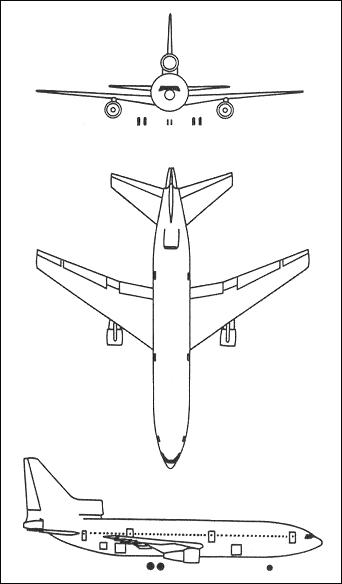 |
Lockheed L-1011 Tri Star1970 |  |
| PASSENGER AIRCRAFT | Virtual Aircraft Museum / USA / Lockheed |
 |
The Lockheed L-1011 TriStar was the third widebody passenger jet airliner to reach the marketplace, following the Boeing 747 "jumbo jet" and the Douglas DC-10. In the 1960s, American Airlines approached Lockheed and competitor Douglas with a need for an aircraft smaller than the existing 747, but still capable of flying to distant locales such as London, the Caribbean, and Latin America from company hubs in Dallas/Ft Worth and New York. Lockheed answered the call with the TriStar. Ironically, American Airlines never flew the "Ten Eleven," purchasing many DC-10s instead. First flown on November 16, 1970, the twin-aisle TriStar was considered a technological marvel of its day, featuring low noise emissions, improved reliability, and efficient operation. The main visible difference between the TriStar and DC-10 is in the middle/tail engine; the DC-10's engine is external for more power, while the TriStar's engine is integrated into the tail through an S-duct (similar to the Boeing 727) for improved quietness and stability. Although the TriStar's design schedule closely followed that of its fierce competitor, the DC-10, Douglas beat Lockheed to market by a year due to delays in powerplant development. Rolls-Royce, the maker of the TriStar's RB211 turbofan engines, had filed for bankruptcy, halting L-1011 final assembly. The British government did not approve the large state subsidy used to restart Rolls-Royce operations until after the U.S. government had guaranteed the Lockheed loans previously provided to Rolls for the extensive engine contract. (The UK Goverment also took the contentious step (for a Conservative administration) of taking the aero-engine side of RR into public ownership, to maintain national defence capability). The first TriStar was finally delivered to Eastern Airlines on April 26, 1972. Designed for a maximum seating of 400 passengers, the TriStar utilized a new engine layout: in addition to Rolls-Royce turbofan jet engines on each wing, a third engine was located dorsally below the vertical stabilizer. Manufactured in Lockheed facilities in Palmdale, California, the TriStar faced brisk competition with the Boeing 747 and, even more directly, the Douglas (later McDonnell Douglas) DC-10/MD-10, which it closely resembled. The TriStar had a better safety record than the DC-10, and Trans World Airlines heralded the TriStar as one of the safest airplanes in the world in some of its promotional literature in the 1980s when concern over the safety record of the DC-10, which was flown by most of its competitors, was at its peak. However, the DC-10 outsold the TriStar nearly two to one, partly because of the TriStar's delayed introduction. A longer-range variant of the standard-length L-1011 was developed in the late 1970s. Designated the L-1011-500, the fuselage length was shortened by 14 feet (4.3 m) to accommodate higher fuel loads. Lockheed manufactured a total of 250 TriStars, ceasing production in 1984. Lockheed needed to sell 500 planes to break even. Failing to achieve profitability in the civilian airliner sector, the TriStar was to be Lockheed's last commercial aircraft. Airlines played Douglas and Lockheed off each other, driving the prices of both planes down, and the end result was Douglas' merger with McDonnell and Lockheed's departure from the commercial aircraft business.
|  COMPANY PROFILE | |||||||||||||||||||||||||||||||||||||||||||||||||||
 |

|

